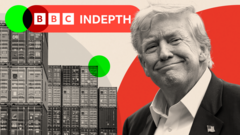As tensions brewed in the global financial landscape following Trump's April tariff announcement, the U.S. President shifted his focus to presenting these moves as successful ventures. His claims of rejuvenating U.S. manufacturing and attracting billions in foreign investment resonate, yet the clarity of these outcomes remains elusive. The initial wave of free trade sentiment was strong; however, it now appears to be evolving into a more guarded approach, prompting nations to seek new alliances in a changing environment.
The pressure to solidify new trade terms emerged prominently, emphasizing a critical deadline of August 1, where countries were warned to finalize agreements or face higher tariffs. Predictably, as the date approached, only limited deals materialized, with many agreements lacking thorough details. For instance, the U.K., which has always had a comparatively balanced trade relationship with the U.S., received a lower 10% tariff on goods, contrasting with the heavier 15% imposed on countries with larger trade deficits, like the EU and Japan.
Yet, the unveiling of tariff agreements has not been without its difficulties. While the initial fears of economic fallout from more stringent tariffs have lessened, the reality is that businesses are adjusting to a new normal marked by higher import costs and heightened uncertainty. The short-term outcomes of these tariffs are not entirely detrimental, with many companies now able to plan ahead with clearer parameters.
However, the implications stretch far beyond immediate gratification. Countries like India may absorb these tariffs with minimal impact, while Germany's economy could face significant setbacks due to the sizeable automotive sector. The emerging industrial landscape could skew favorably toward nations like Vietnam, which might capitalize on lower tariffs for their own exports to the U.S.
Attention turns toward the implications these tariffs have for domestic U.S. consumers, who are just beginning to confront the raise in prices resulting from these trade policies. Already, large firms have logged rising costs, threatening to undermine the economic advantage promised by tariff revenue. The political ramifications for Trump, informed by a pledge to lower costs for blue-collar workers, could become contentious as consumer dissatisfaction surfaces.
Amidst these dynamics, many trade negotiations remain incomplete, particularly with major partners such as Canada and Taiwan. The potential resolutions surrounding tariffs on pharmaceuticals and steels remain uncertain, as does the comprehensive framework for managing trade with China. The stakes of these discussions could weigh heavily on future economic sentiment and strategic partnerships.
Ultimately, the approach Trump's administration has taken towards tariffs may foster immediate revenue streams but could also usher in a fundamental shift in global trade relations. As leaders and economists analyze the details, the long-term implications for American workers and industries could diverge significantly from initial projections. The evolving nature of international trade partnerships may prompt a reformed landscape that may not necessarily favor the U.S. Moving forward, both economists and policymakers must remain cognizant of these unfolding economic realities.
The pressure to solidify new trade terms emerged prominently, emphasizing a critical deadline of August 1, where countries were warned to finalize agreements or face higher tariffs. Predictably, as the date approached, only limited deals materialized, with many agreements lacking thorough details. For instance, the U.K., which has always had a comparatively balanced trade relationship with the U.S., received a lower 10% tariff on goods, contrasting with the heavier 15% imposed on countries with larger trade deficits, like the EU and Japan.
Yet, the unveiling of tariff agreements has not been without its difficulties. While the initial fears of economic fallout from more stringent tariffs have lessened, the reality is that businesses are adjusting to a new normal marked by higher import costs and heightened uncertainty. The short-term outcomes of these tariffs are not entirely detrimental, with many companies now able to plan ahead with clearer parameters.
However, the implications stretch far beyond immediate gratification. Countries like India may absorb these tariffs with minimal impact, while Germany's economy could face significant setbacks due to the sizeable automotive sector. The emerging industrial landscape could skew favorably toward nations like Vietnam, which might capitalize on lower tariffs for their own exports to the U.S.
Attention turns toward the implications these tariffs have for domestic U.S. consumers, who are just beginning to confront the raise in prices resulting from these trade policies. Already, large firms have logged rising costs, threatening to undermine the economic advantage promised by tariff revenue. The political ramifications for Trump, informed by a pledge to lower costs for blue-collar workers, could become contentious as consumer dissatisfaction surfaces.
Amidst these dynamics, many trade negotiations remain incomplete, particularly with major partners such as Canada and Taiwan. The potential resolutions surrounding tariffs on pharmaceuticals and steels remain uncertain, as does the comprehensive framework for managing trade with China. The stakes of these discussions could weigh heavily on future economic sentiment and strategic partnerships.
Ultimately, the approach Trump's administration has taken towards tariffs may foster immediate revenue streams but could also usher in a fundamental shift in global trade relations. As leaders and economists analyze the details, the long-term implications for American workers and industries could diverge significantly from initial projections. The evolving nature of international trade partnerships may prompt a reformed landscape that may not necessarily favor the U.S. Moving forward, both economists and policymakers must remain cognizant of these unfolding economic realities.





















